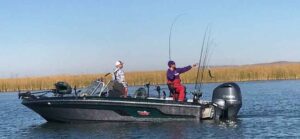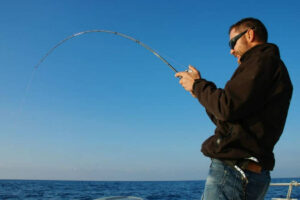Best Lures and Techniques to Catch Coho Salmon in Oregon
Coho Salmon season is coming, and you know what that means! It’s time to begin prepping your gear and head to Oregon to catch some big ones to eat or release. One of the things you’ll need to think about when catching Coho salmon is the proper lures and techniques to use.
So, what are the best lures and techniques to catch Coho salmon in Oregon? This article will tackle what you need to know for more success in salmon fishing.
Best Lures and Techniques to Catch Coho Salmon in Oregon
Coho salmon are also known as silver salmon or silvers, which are popular around Oregon. They are part of the pacific salmon family, with white gums, black tongues, and bodies that are either silver or red in color, depending on their age and gender.
Coho salmon can weigh between 5-15 pounds and measure 17-24 inches long. Some anglers can find Coho salmon weighing over 30 pounds and up to 38 inches long!
Here are the Coho salmon fishing lures you should consider using if you want more chances of getting a bite, depending on the technique you’ll use:
Open Ocean Trolling
Trolling is one of the most common techniques when fishing for Coho salmon. It’s effective in most stages of the salmon spawn cycle, whether you’re in the open ocean or upriver.
With open ocean trolling, we recommend using green and pink hoochie squids. If that doesn’t work, opt for cut plug herrings and spoons. You can also use a meat rig now and then, mixing things up to see which is most effective.
Based on experience, hoochie squids offer the most success, though sometimes only real fish lures would get the Coho salmon to bite!
Another recommendation is to use downriggers, which are effective when trolling for Coho salmon. If you have no downriggers, that’s fine! Drop your chosen lure down to 20-30 feet wherever you see fish on the fish finder.
If you want more exciting surface strikes, go for top-level hoochie squid lures when the bites are hot.
If you plan to use fish, opt for cut plug herring. But take note that the herring’s shape and quality would start degrading while dragging it through the water. Make sure that you cut this lure correctly and check it every 20 minutes, changing it when the spinning action isn’t at its best.
Regardless of the lure you use, coat it with a fish scent of anise oil to hide the human smell from the salmon.
Bays and Inlet Trolling
For trolling in bays and inlets, you can use the lures mentioned above for open ocean trolling. The difference here is to adjust the lure depth appropriately, around 15-20 feet in bays.
Bays and inlets aren’t as deep as the open ocean, so that you can get away without a downrigger and use lead weights or large divers. If you’re trolling for Coho salmon inland, we recommend you go crabbing, too!

River Back Trolling
People go back trolling in rivers once the Coho salmon run begins in September to October. Back trolling is similar to the typical trolling technique, but this time, you’ll anchor the boat and let the river’s tide or current troll the lure.
When attempting this fishing technique, we recommend using cured salmon roe as bait. You can also use a green or silver Kwikfish lure or salmon bead rig to avoid messing with the roe. Rivers are shallower than inlets and bays, so you can use a small diver or pencil lead weight to bring the lure to Coho salmon.
During this time, Coho salmon are swimming upstream and aren’t feeding. That said, they are pretty aggressive and you can still catch a few of them. The spawning process changes their body chemistries, causing them to feel agitated quickly. Opt for bright-colored lures or roe, which irritates them until they lash out at the lure.
Cured salmon roe also attracts Coho salmon that are experiencing spawning aggression. If you are fishing deeper than 4 feet with a slow current, opt for float fishing using cured salmon row.

Jigging
Another effective method is jigging, which is effective when fishing Coho salmon in open oceans, bays, or sounds with appropriate depths. For this technique, we recommend using medium to large candlefish lures or buzz bombs.
When jigging in open oceans, drop the lures to about 40 feet. For bays, let the lure drop to the bottom, reeling up 6-7 turns. Jig lures by pulling your fishing rod up swiftly by around 6 feet, then allows the lure to drift down to resting position.
Perform this technique every 2 seconds or so, changing your cadence at times to imitate wounded fish movements. When you feel something going on with the lure, quickly reel it in because you either got a bite or hit bottom.
You can also opt for twitching jigs, with the jigging action triggering Coho salmon so that you can expect violent strikes.

Spinning
If you’re spinning for Coho salmon, opt for medium to large Kastmaster spoons or Blue Fox Vibrax spinners in bright colors like silver, pink, or chartreuse.
When using these lures, cast them in front of the area where you believe Coho salmon are swimming, retrieving it steadily or in small jerks every few seconds. Doing small jerks can entice hesitant yet curious Coho salmon.
Wrapping It Up
There are numerous lures and techniques to use when catching Coho salmon in Oregon. You can follow any of the tips above, but make sure that it follows the rules and regulations of the area you’re in. Then experiment with the different lures and techniques, seeing what works best for you.
We hope that this article helped you out! Once you prepared your gear, look into hiring a fishing charter in Oregon like us here at Newport Oregon Fishing Charters to get you to where the Coho salmon are. Happy fishing, and contact us for fishing charter services now!
Coho Salmon season is coming, and you know what that means! It’s time to begin prepping your gear and head to Oregon to catch some big ones to eat or release. One of the things you’ll need to think about when catching Coho salmon is the proper lures and techniques to use.
So, what are the best lures and techniques to catch Coho salmon in Oregon? This article will tackle what you need to know for more success in salmon fishing.
Best Lures and Techniques to Catch Coho Salmon in Oregon
Coho salmon are also known as silver salmon or silvers, which are popular around Oregon. They are part of the pacific salmon family, with white gums, black tongues, and bodies that are either silver or red in color, depending on their age and gender.
Coho salmon can weigh between 5-15 pounds and measure 17-24 inches long. Some anglers can find Coho salmon weighing over 30 pounds and up to 38 inches long!
Here are the Coho salmon fishing lures you should consider using if you want more chances of getting a bite, depending on the technique you’ll use:
Open Ocean Trolling
Trolling is one of the most common techniques when fishing for Coho salmon. It’s effective in most stages of the salmon spawn cycle, whether you’re in the open ocean or upriver.
With open ocean trolling, we recommend using green and pink hoochie squids. If that doesn’t work, opt for cut plug herrings and spoons. You can also use a meat rig now and then, mixing things up to see which is most effective.
Based on experience, hoochie squids offer the most success, though sometimes only real fish lures would get the Coho salmon to bite!
Another recommendation is to use downriggers, which are effective when trolling for Coho salmon. If you have no downriggers, that’s fine! Drop your chosen lure down to 20-30 feet wherever you see fish on the fish finder.
If you want more exciting surface strikes, go for top-level hoochie squid lures when the bites are hot.
If you plan to use fish, opt for cut plug herring. But take note that the herring’s shape and quality would start degrading while dragging it through the water. Make sure that you cut this lure correctly and check it every 20 minutes, changing it when the spinning action isn’t at its best.
Regardless of the lure you use, coat it with a fish scent of anise oil to hide the human smell from the salmon.
Bays and Inlet Trolling
For trolling in bays and inlets, you can use the lures mentioned above for open ocean trolling. The difference here is to adjust the lure depth appropriately, around 15-20 feet in bays.
Bays and inlets aren’t as deep as the open ocean, so that you can get away without a downrigger and use lead weights or large divers. If you’re trolling for Coho salmon inland, we recommend you go crabbing, too!

River Back Trolling
People go back trolling in rivers once the Coho salmon run begins in September to October. Back trolling is similar to the typical trolling technique, but this time, you’ll anchor the boat and let the river’s tide or current troll the lure.
When attempting this fishing technique, we recommend using cured salmon roe as bait. You can also use a green or silver Kwikfish lure or salmon bead rig to avoid messing with the roe. Rivers are shallower than inlets and bays, so you can use a small diver or pencil lead weight to bring the lure to Coho salmon.
During this time, Coho salmon are swimming upstream and aren’t feeding. That said, they are pretty aggressive and you can still catch a few of them. The spawning process changes their body chemistries, causing them to feel agitated quickly. Opt for bright-colored lures or roe, which irritates them until they lash out at the lure.
Cured salmon roe also attracts Coho salmon that are experiencing spawning aggression. If you are fishing deeper than 4 feet with a slow current, opt for float fishing using cured salmon row.

Jigging
Another effective method is jigging, which is effective when fishing Coho salmon in open oceans, bays, or sounds with appropriate depths. For this technique, we recommend using medium to large candlefish lures or buzz bombs.
When jigging in open oceans, drop the lures to about 40 feet. For bays, let the lure drop to the bottom, reeling up 6-7 turns. Jig lures by pulling your fishing rod up swiftly by around 6 feet, then allows the lure to drift down to resting position.
Perform this technique every 2 seconds or so, changing your cadence at times to imitate wounded fish movements. When you feel something going on with the lure, quickly reel it in because you either got a bite or hit bottom.
You can also opt for twitching jigs, with the jigging action triggering Coho salmon so that you can expect violent strikes.

Spinning
If you’re spinning for Coho salmon, opt for medium to large Kastmaster spoons or Blue Fox Vibrax spinners in bright colors like silver, pink, or chartreuse.
When using these lures, cast them in front of the area where you believe Coho salmon are swimming, retrieving it steadily or in small jerks every few seconds. Doing small jerks can entice hesitant yet curious Coho salmon.
Wrapping It Up
There are numerous lures and techniques to use when catching Coho salmon in Oregon. You can follow any of the tips above, but make sure that it follows the rules and regulations of the area you’re in. Then experiment with the different lures and techniques, seeing what works best for you.
We hope that this article helped you out! Once you prepared your gear, look into hiring a fishing charter in Oregon like us here at Newport Oregon Fishing Charters to get you to where the Coho salmon are. Happy fishing, and contact us for fishing charter services now!
Let’s Get Started


